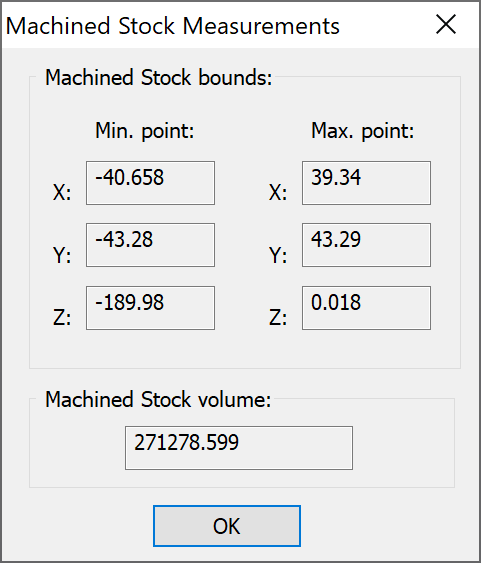Simulation menu

File
Open machined stock from FCT
This option enables you to load the machined stock model from the SolidCAM FCT file (*.fct).
Open machined stock from STL
This option enables you to load the machined stock model from the Stereolithography file (*.stl).
Save machined stock to FCT
This option enables you to save the machined stock model to the SolidCAM FCT file (*.fct).
Save machined stock to STL
This option enables you to save the machined stock model to the Stereolithography file (*.stl).
Options
This option enables you to compare the stock model and target model and assign different colors to different rest material areas, depending on their tolerance.
This option displays the Machined Stock Measurements dialog box where you can see the dimensions and the volume of the Machined stock model.
Settings
Visual properties
This option enables you to define colors and transparency for the simulation. The Visual Properties dialog box is displayed.
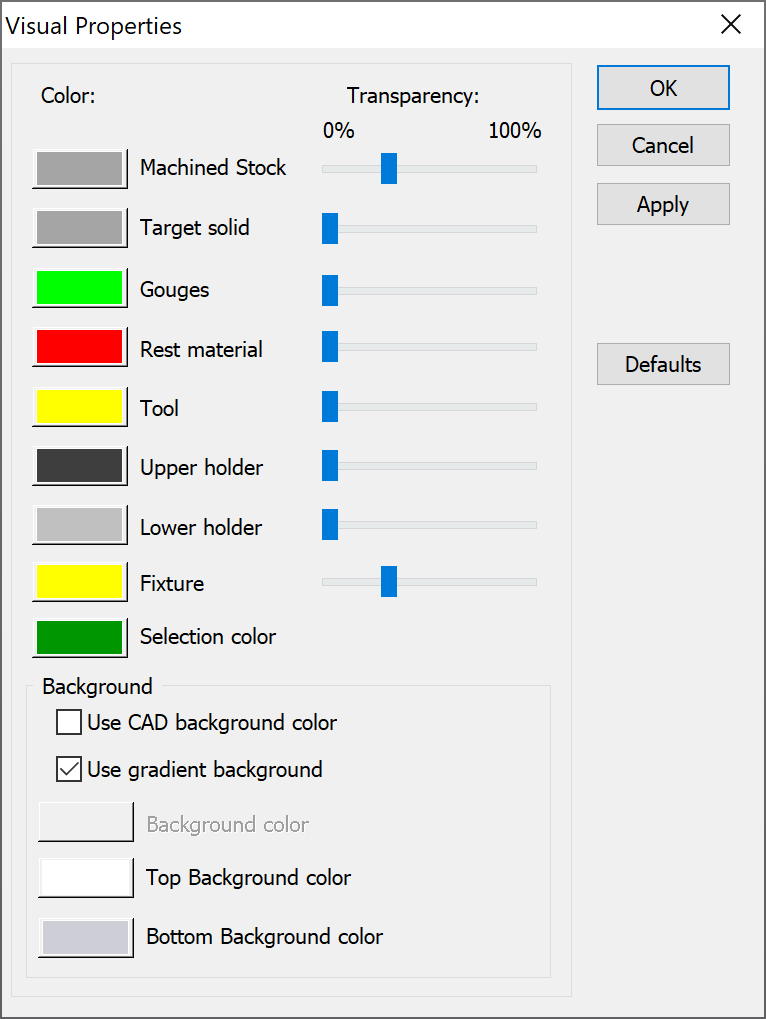
The Use CAD background color check box enables you to apply the simulation background color provided by the CAD system.
The Use gradient background check box enables you to apply the gradient background to the graphics area. Specify colors for Top Background Color and Bottom Background Color.
General
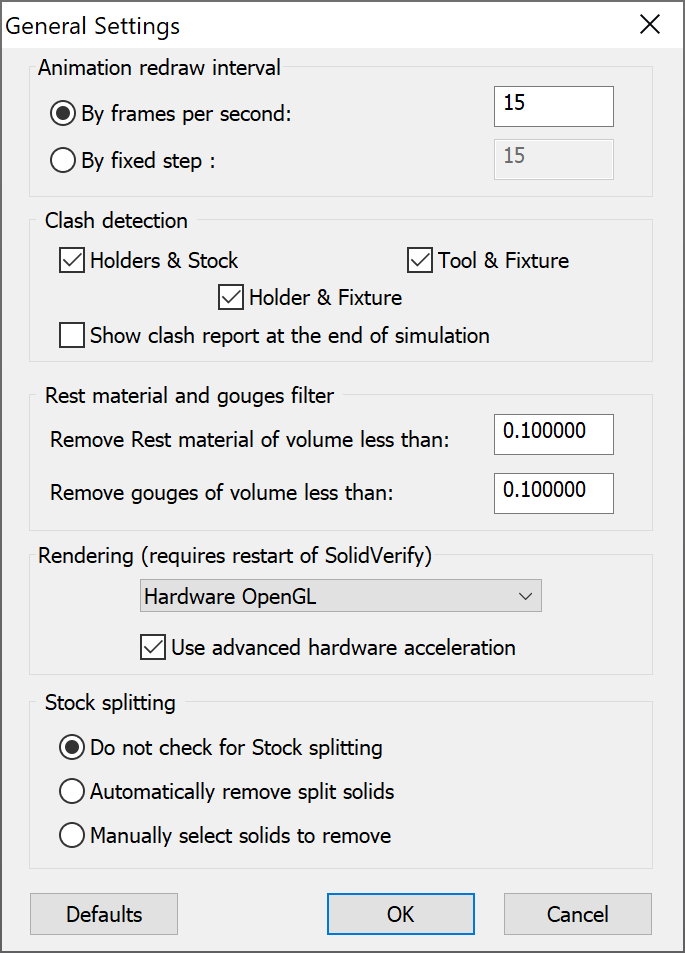
The By frames per second option enables you to expedite the simulation by defining the number of animation frames until the next redraw of the display.
The By fixed step option enables you to expedite the simulation by defining the number of tool movements until the next redraw of the display.
SolidCAM enables you to check the possible collisions between different components participating in the machining (tool, tool holder, machined stock model and fixture) during the simulation.
Holders and Stock - this option enables you to check the possible collisions between the tool holder and the machined stock model.
Tool and Fixture - this option enables you to check the possible collisions between the tool and the fixture model.
Holders and Fixture - this option enables you to check the possible collisions between the tool holder and the fixture.
Show clash report at the end of simulation - this option enables you to display a list of crashes at the end of simulation. If this option is not selected, each collision is reported in a separate warning message.
Rest material and gouges filter
Remove Rest Material of volume less than: SolidCAM enables you to define the tolerance of the Rest material visualization.
Remove gouges of volume less than: SolidCAM enables you to define the tolerance of the Gouge areas visualization.
The functionality is implemented to improve the simulation performance with different graphic adapters. The OpenGL rendering options enable you to switch between the software/hardware OpenGL acceleration.
Software Open GL – disables the OpenGL hardware capabilities and enables graphics rendering using software only. For many graphic cards, this results in slower performance. Select this option only if instructed to do so by technical support. This option enables you to solve the visualisation troubles if your graphic card does not support hardware acceleration, or does not support it for the current combination of resolution, number of colors, refresh rate, and so forth.
Hardware Open GL – the hardware OpenGL provided by your graphics adapter will be used. The Use advanced hardware acceleration option enables you to use hardware acceleration provided by your graphic adapter.
Direct X - this option is used for rendering during simulation with some graphic cards.
During the machining, the tool cuts off the material pieces. These pieces fall down from the machining area. This option enables you to automatically determine and remove such material pieces.
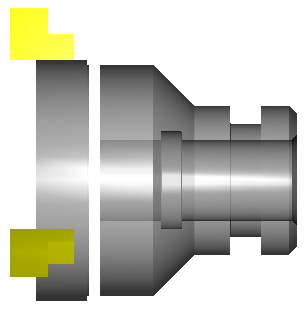
The Stock splitting options enable you to control the process of automatic removal of cut off pieces.
When this option is chosen, SolidCAM does not check the simulation solid model for splits. The cut off material pieces can be hidden or removed manually using the Show/Hide Split Solids dialog box.
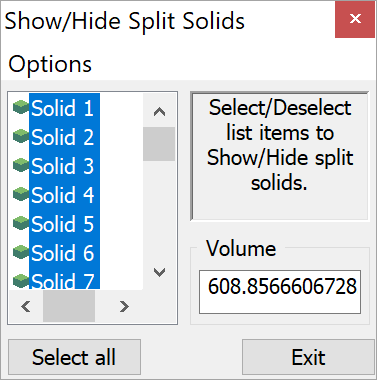
When this option is chosen, SolidCAM automatically determines stock splitting. When the split is determined, SolidCAM compares two resulting solids and automatically removes the smaller one.
When this option is chosen, SolidCAM automatically determines stock splitting and the following message is displayed:

Show & Remove. The simulation is paused and the Show/Hide Split Solids dialog box is displayed. This dialog box enables you to hide or remove the cut off material pieces.
Ignore. The simulation will be continued till the next split is determined. When the simulation is finished, the Show/Hide Split Solids dialog box is displayed. This dialog box enables you to hide or remove the cut off material pieces.
Stop monitoring. The simulation is continued till the end without monitoring of splits.
Accuracy
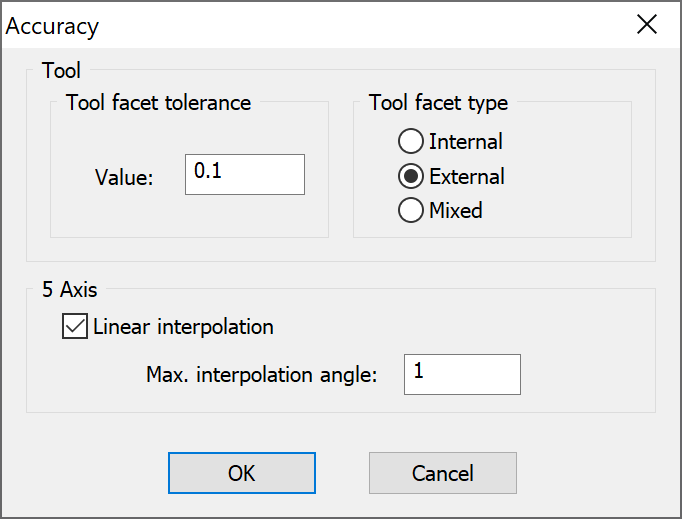
This option controls the precision of the tool for the simulation. The value defines the precision of the tool facets in millimeters or inches. Since this is an absolute value, the facet tolerance for small and large tools is the same. During the simulation, SolidCAM produces the Boolean subtraction of the tool from the CAM-Part.
The tolerance influences the quality of the simulation. The quality of the simulation is the same for large and small tools. The speed of the simulation depends on the tool. The simulation of larger tools is slower.
As well as changing the tolerance used for faceting, the application controls the manner in which the faceted tool representation approximates the tool by forcing the representation to be bigger or smaller than the actual tool. For example, if you want to know whether the tool gouged the target part, then it would be preferable for SolidVerify to have a tool representation that was guaranteed to lie outside the bounds of the actual tool.
Internal – The tool representation lies within the actual tool. The vertices of the tool representation will lie on the surface of the actual tool and the facets will lie within the actual tool.
External – The actual tool lies within the tool representation. The vertices will lie at distances up to the faceting tolerance from the surface of the actual tool.
Mixed – This is a combination of Internal and External. The vertices lie outside the actual tool but parts of the facets may lie inside it. This mode is the default and should be used unless there is a specific reason for using one of the other modes as it generates fewer facets and will therefore be faster.
Delete Updated Stock files
The Delete Updated Stock files command enables you to erase all the USM files of the current CAM-Part. This command is unavailable in the Manual mode.
Tools
Self-intersections

Many problems occur in SolidVerify simulations if the solids used (Machined Stock model, Target model or Fixture) are not topologically valid. In particular, SolidVerify is likely to encounter problems with solids that contain self-intersections - that is, solids which contain pairs of polygons which overlap each other, or individual polygons whose edges cross.
Self-intersections can be encountered in the following cases:
The model (Stock, Target or Fixture) is based on a SOLIDWORKS assembly or sub-assembly containing a number of components.
The model (Stock, Target or Fixture) is based on a SOLIDWORKS part containing a number of disjointed solid bodies.
The model (Stock, Target or Fixture) is based on a SOLIDWORKS part with corrupted geometry (gaps, self-intersections, etc.).
Such self-intersection problems can be solved by SOLIDWORKS tools.
Related Topics
